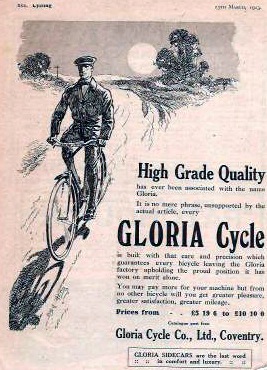GLORIA CYCLE CO
The Gloria Cycles are right on top! We are keeping abreast of the times! Having doubled the size of our Works, we are now in a position to place on the market an exceptionally high-grade ‘Gloria’ at the lowest possible price.
The patronage and expressions of appreciation we have received in the past, have given us great confidence in our venture. We shall embody in the ‘Gloria’ material of highest quality, and they will be finished in our usual lavish style.
We cannot do better than repeat the motto we have used in connection with our manufacture from the inauguration of the company –
A PERFECT CYCLE AT A LOW FIGURE
– THE GLORIA CYCLE Co Ltd, November, 1904
The Gloria Cycle Co was apparently set up in Coventry in 1898. I’m not sure at what stage Gloria became a subsidiary of Triumph, or whether it was a Triumph company from the outset, but Triumph used both names for their bicycles, the Gloria name being used for cheaper machines.
THE TRIUMPH GLORIA:
from BICYCLE to MOTORCYCLE to CAR

Gloria bicycles were extensively advertised (1913 advert above) and also exported, as can be seen from the following advert in New Zealand’s Wanganui Herald, from 11 November 1903:
With the increasing success of their motorcycle business over the first three decades of the 20th century, that became Triumph’s main focus. This Gloria Roadster would have been one of the last Triumph bicycles to bear the name because, from 1932 the Gloria became a motorcycle and, from 1933, a car.
My first postwar vintage motorcycle was a Triumph Speed Twin Combination purchased in 1973 (bought for £20, crashed, sold for £25). A 98cc Gloria (see below) was my first pre-war vintage motorcycle; I owned it from 1980-1993.
In 1933 Triumph Motor Co decided on a change in direction for their car production, and Donald Healey joined the company. The small Triumph saloon cars had helped the company manage through the depression years, but Triumph now decided to add some glory to their four wheelers. They decided the time was right for larger sports saloons, and the result was the Triumph Gloria series. This ran from 1933 to 1937 with around 30 variations based on three chassis lengths, four engine sizes, standard or Vitesse tuned and various bodies.
The Gloria was raced successfully. A 1935 advert in The Motor celebrating Jack Ridley’s 2346 mile run from the Arctic Circle in a Gloria can be seen below.
My favourite style of Triumph Gloria is the Flow-Free Saloon.
TRIUMPH GLORIAS AT THE MUSEUM
This is the first published study of The Triumph Gloria bicycle. Many thanks to Andrew Heaps for sharing his knowledge on them, as well as his 1906 Gloria catalogue. The location of Triumph frame numbers is unique – stamped on the top of the bottom bracket. I was intrigued when I obtained my first Gloria, as it had many Triumph features; but if it had been a Triumph its frame number would have made it a 1904 model, which it obviously was not.
Andrew explained that Gloria frame numbers are a separate sequence from normal Triumphs. While it is possible to confirm the age of Triumphs from their numbers and catalogues, no records have been kept for Gloria Cycle Co, so we must use other means to date them, eg their Sturmey-Archer gears.
There are four Triumph Gloria bicycles in the Museum. The first three were made around WW1, and they each have different chain wheels:
The 1913 Gloria has a common ‘bought-in’ chainwheel. It also has a Sturmey-Archer ‘FX’ three-speed and roller levers for brakes.
The 1915 Gloria has a six-pointed star chainwheel (as illustrated in the 1906 Gloria catalogue) and Triumph inverted levers.
The 1918 has a Triumph pattern chainwheel, Sturmey-Archer ‘FN’ Tricoaster, and Triumph inverted lever.
The location of the frame number varies: the first two are stamped like conventional Triumphs, above the bottom bracket; on the 1918 it is stamped below the saddle like most other manufacturers.
In estimating the age of the three early Glorias, I have assumed that their numbers, like Triumph serial numbers, are in sequence.
Triumph increased production during WW1. The company was a major government contractor for the supply of motorcycles and bicycles. With all motorised transportation need for war, there was great demand for bicycles at home. So it is no coincidence that the majority of surviving Triumph bicycles are from the WW1 era.
The fourth Gloria is from 1931 and retains its Gloria transfers.
1913 TRIUMPH GLORIA THREE-SPEED ROADSTER
1913 TRIUMPH GLORIA THREE SPEED
1915 TRIUMPH GLORIA ROADSTER
1918 TRIUMPH GLORIA THREE-SPEED ROADSTER
1918 TRIUMPH GLORIA THREE SPEED
1931 TRIUMPH-GLORIA MODEL H FULL ROADSTER
1931 TRIUMPH-GLORIA FULL ROADSTER
1905 GLORIA CYCLE CO CATALOGUE
1905 GLORIA CYCLE CO CATALOGUE
EXCLESIOR-GLORIA TYRES
Germany





















